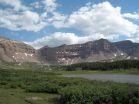(Press-News.org) MINNEAPOLIS / ST. PAUL (7/9/2015) -- Draining tropical peatlands for oil palm plantations may result in nearly twice as much carbon loss as official estimates, according to a new study by researchers from the University of Minnesota Institute on the Environment and the Union of Concerned Scientists in the journal Environmental Research Letters.
Peatlands -- waterlogged, organic soils -- have developed over thousands of years as carbon storage systems. In Southeast Asia, peat swamp forests cover about 250,000 square kilometers, a land area about the size of Michigan. In the past 15 years, peatland forests have been rapidly drained and cleared to make way for oil palm and pulpwood plantations. Draining exposes the upper peat layer to oxygen, raising decomposition rates and soil carbon losses. Most of that carbon is emitted to the atmosphere, speeding up climate change.
Kimberly M. Carlson, a postdoctoral research scholar with IonE's Global Landscapes Initiative, and UCS researchers Lael K. Goodman and Calen C. May-Tobin designed their research to support site-specific greenhouse gas emissions assessments in tropical plantations. "We wanted to know whether water table depth could be used as a proxy for soil carbon loss in peatland plantations," Carlson explained.
Major international companies that buy and sell products sourced from peatland plantations have committed to reducing their climate footprints. These companies can now trace a product through the supply chain back to its source. Consequently, specific information about the carbon balance of a producing plantation helps companies and consumers better understand the climate implications of purchasing choices.
The study, a comprehensive analysis of scientific literature on tropical plantation peatland carbon balance, found a correlation between long-term water table depth (the distance from the soil surface to the water surface) and soil carbon loss rate. This finding suggests that peat water table monitoring could help companies more accurately measure their greenhouse gas emissions.
The researchers compared two measurements of carbon loss: subsidence and mass balance. To find the subsidence rate, scientists measure how much the land has sunk over time and how much carbon is stored in the soil. Subsidence models alone cannot inform the global warming potential of peatland drainage.
Mass balance models estimate carbon emissions from the balance of carbon gains such as leaf decomposition and losses such as soil carbon dioxide emissions. With this method, both carbon dioxide and methane -- a much more potent greenhouse gas -- can be measured, permitting more accurate global warming potential assessments.
Carbon losses calculated from mass balance and subsidence methods differed substantially for oil palm plantations. At plantation drainage depths of 70 centimeters, the annual rate of carbon loss determined from the subsidence method is about 20 tons of carbon per hectare per year. This is almost twice the rate of 12 tons of carbon per hectare per year that the International Panel on Climate Change uses to calculate emissions from oil palm land use. This rate, as put forth in the 2013 Supplement to the 2006 Guidelines for National Greenhouse Gas Inventories: Wetlands, is partly based on the mass balance method.
The researchers caution that additional field studies are needed to reconcile these estimates. "While our calculations take advantage of an exciting set of newly published data, a serious lack of research in tropical peatlands means that such estimates of peat carbon loss from plantation systems remain uncertain, and are frequently based on assumptions rather than empirical measurements," Carlson said.
Water table depth is only one of many factors, such as fertilizer application, that should be considered when quantifying carbon losses from cultivated peatlands.
Key findings of the study:
The lower the water table, the higher the rate of carbon loss.
More studies in tropical peatland plantations are needed to reduce uncertainty about the global warming potential of peat drainage.
The authors emphasize that reducing greenhouse gas emissions from peat requires preventing plantation expansion into intact peat swamp forests. "Our findings lend weight to the idea that draining peat soils should be avoided at all costs, due to the impact on global climate," Goodman said.
INFORMATION:
The article, "Modeling relationships between water table depth and peat soil carbon loss in Southeast Asian plantations," was written with support from the Gordon and Betty Moore Foundation, National Academies Keck Futures Initiative, and the European Federation for Transport & Environment.
The University of Minnesota's Institute on the Environment seeks lasting solutions to Earth's biggest challenges through research, partnerships and leadership development. For more information, visit environment.umn.edu.
Scientists at the University of East Anglia in collaboration with the University Pompeu Fabra in Barcelona have found a way to separate the medical benefits of cannabis from its unwanted side effects.
The research comes from the team that discovered how the main psychoactive ingredient in cannabis, known as THC, reduces tumour growth in cancer patients.
Their latest findings, published today in the journal PLOS Biology, reveal how the cognitive effects of THC are triggered by a pathway which is separate from some of its other effects.
That pathway involves both a ...
Neutralizing antibodies (Nabs) are immune proteins that recognize, bind to, and trigger the elimination of virus before it can establish a chronic infection. How to elicit a potent Nab response capable of protecting against different HIV subtypes and against different modes of infection is critical to the development of an AIDS vaccine. Two studies published on July 9th in PLOS Pathogens provide results on Nabs that could help guide vaccine design. One shows what type of Nab "repertoire" can be generated following superinfection, and the second one examines the efficacy ...
SALT LAKE CITY, July 9, 2015 - More than a quarter of the rain and snow that falls on continents reaches the oceans as runoff. Now a new study helps show where the rest goes: two-thirds of the remaining water is released by plants, more than a quarter lands on leaves and evaporates and what's left evaporates from soil and from lakes, rivers and streams.
"The question is, when rain falls on the landscape, where does it go?" says University of Utah geochemist Gabe Bowen, senior author of the study published today in the journal Science. "The water on the continents sustains ...
Global warming is putting the squeeze on bumblebees. In the most comprehensive study ever conducted of the impacts of climate change on critical pollinators, scientists have discovered that global warming is rapidly shrinking the area where these bees are found in both North America and Europe.
Researchers examined more than 420,000 historical and current records of many species of bumblebees--and confirm that bumblebees are in steep decline at a continental scale because of climate change. The new research is reported in the journal Science.
ECONOMIC THREATS
This ...
The discovery of a fiber-reinforced, concrete-like rock formed in the depths of a dormant supervolcano could help explain the unusual ground swelling that led to the evacuation of an Italian port city and inspire durable building materials in the future, Stanford scientists say.
The "natural concrete" at the Campi Flegrei volcano is similar to Roman concrete, a legendary compound invented by the Romans and used to construct the Pantheon, the Coliseum, and ancient shipping ports throughout the Mediterranean.
"This implies the existence of a natural process in the subsurface ...
Researchers from the University of Calgary and University of Ottawa have made an astonishing find when it comes to the habitat range of bumble bees, and the results are troubling.
Findings to be published in the Journal Science, demonstrate that climate change is having a significant impact on bumblebee species in North America and Europe.
Bumblebees are losing vital habitat in the southern regions of North America and Europe, which is cause for concern but another pressing issue is that bumblebee species generally haven't expanded north," explains Paul Galpern, Assistant ...
TORONTO, July 9, 2015 - Bumblebees are rapidly declining in both North America and Europe, and a new study points to climate change as the major factor. The study, a comprehensive analysis of how climate change impacts these critical pollinators, was published in Science today.
The research shows that bumblebees are losing large amounts of the southern portion of their ranges, but unlike other species which are compensating by moving further north as the climate warms, bumblebees are not heading north. Their range areas are compressing with rapid warming and this is causing ...
This news release is available in Japanese.
A suite of energy-saving traits, including underactive thyroid glands, allows giant panda bears to survive almost exclusively on bamboo, according to a new study. Yonggang Nie and colleagues report the first measurements of daily energy expenditure (DEE) in these bears, which do not have stomachs designed for such low-nutrient, high-cellulose plants. The researchers studied five captive pandas and three wild ones, discovering that the animal's DEE was just about 38% of the average for a terrestrial mammal with ...
This news release is available in Japanese. How does the Campi Flegrei caldera, or subsurface rock, near Naples, Italy, withstand more uplift than other calderas without erupting? A new study shows that the caprock underlying this particular caldera closely resembles ancient Roman concrete -- and that the rock's microstructures, characterized by intertwining fibrous minerals, lead to its exceptionally high strength. The findings help to explain how the caldera has been able to withstand tremendous deformation, such as the large uplift episode that began in 1982 and raised ...
This news release is available in Japanese.
While the geographic ranges of many animals are expanding northward in response to climate change, those of North American and European bumblebee species are shrinking, a new study shows. These insects are failing to migrate northward, the study reveals, and in their southern territories, their ranges are compressing -- with range losses up to 300 kilometers in both North America and Europe. The findings reveal the vulnerability of these pollinators, which play key roles in agriculture, to a warming world, hinting that they ...




